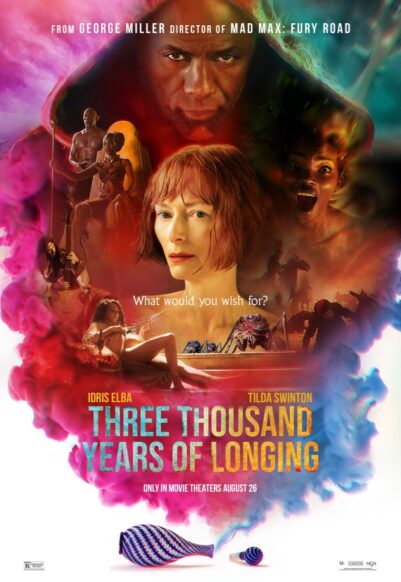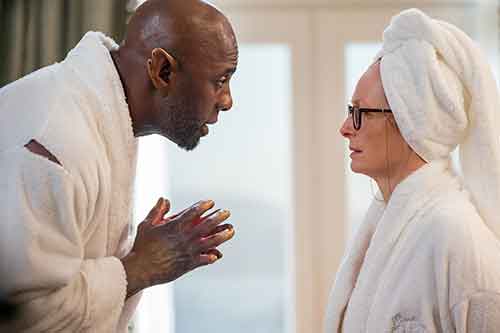 One of the more notable box office flops of 2022 was this ambitious ARABIAN NIGHTS themed fantasy from the great George Miller. Intellectually grounded and adult-oriented, the $60 million budgeted THREE THOUSAND YEARS OF LONGING never had much chance of commercial success, and was further hobbled by the fact that it preceded the filming of Miller’s MAD MAX prequel FURIOSA, the anticipation for which rendered THREE THOUSAND YEARS OF LONGING an immediate afterthought in the minds of both the public and the media.
One of the more notable box office flops of 2022 was this ambitious ARABIAN NIGHTS themed fantasy from the great George Miller. Intellectually grounded and adult-oriented, the $60 million budgeted THREE THOUSAND YEARS OF LONGING never had much chance of commercial success, and was further hobbled by the fact that it preceded the filming of Miller’s MAD MAX prequel FURIOSA, the anticipation for which rendered THREE THOUSAND YEARS OF LONGING an immediate afterthought in the minds of both the public and the media.
Intellectually grounded and adult-oriented, the $60 million budgeted THREE THOUSAND YEARS OF LONGING never had much chance of commercial success…
Adapted from A.S. Byatt’s 1994 novella “The Djinn in the Nightingale’s Eye,” the film represents Miller’s second attempt at transposing a literary fantasy. The first was 1987’s THE WITCHES OF EASTWICK, which famously wreaked havoc on John Updike’s source novel, and THREE THOUSAND YEARS OF LONGING’s take on Byatt’s academically-inclined text isn’t too far removed. Many viewers have complained that Miller begins the film with an interminable three minute lecture about the nature of storytelling and the role of mythology in history, yet the novella is taken up with roughly forty pages of scholarly dissertation before its core narrative, about a middle aged woman academic who meets a Djinn, kicks in.
The woman in question is Alithea (Tilda Swinton), who while stationed in Istanbul purchases an antique bottle from which the Djinn (Idris Elba) emerges. His initial appearance is via a giant foot appearing in a doorway, but eventually he shrinks down to human size and does what djinns are prone to do: he offers Alithea three wishes. Knowing that djinns are notorious tricksters she avers, leading him to relate three episodes from his existence, visualized by Miller and the wizardly cinematography of John Seale.
We see the Djinn woo the Queen of Sheba (Aamito Lagum) and get confined to the bottle by her chief suitor King Solomon (Nicolas Mouawad). The Djinn is released 2500 years later by a young concubine (Ece Yüksel) who wishes for the Ottoman Empire’s Prince Mustafa (Matteo Bocelli) to fall in love with her, only to become caught up in the political machinations of the palace of Mustafa’s father Suleiman the Conqueror (Lachy Hulme).
The Djinn is subsequently confined to the palace for a hundred years. The bottle is trapped under a loose stepping stone that’s dislodged by a rotund concubine (Anna Adams) of Sultan Murad IV (Ogulcan Arman Uslu), who uses her first wish to cast the Djinn into the ocean. He winds up in the care of Zefir, a young 19th Century Turkish woman (Burcu Gölgedar) who wishes for increased knowledge, which he grants. Yet Zefir grows so smart she loses interest in the Djinn, who has fallen in love with and conceived a child with her, and she uses her third wish to banish him from her mind and return him to the bottle.
Back in the present Alithea decides to finally take the Djinn up on his offer, wishing to have sex with him. He grants this wish, after which the two head back to Alithea’s home in London. There the Djinn finds himself increasingly out of place, and beings to wither, although (as the happy ending makes clear) he doesn’t quite die.
Miller has created an eye-catching film that incorporates traditional hand drawn animation, copious CGI and innumerable visual quirks into what due to Miller’s skill and assurance registers as a smooth and assured viewing experience. The highly color-conscious photography by John Seale ensures that the proceedings are always fun to watch, aided by the propulsive editing of Miller’s longtime wife and collaborator Margaret Sixel, and in the lead roles Tilda Swinton and Idris Elba are definitely game. But there’s a definite tension to the film, an inevitability given that such academically inclined material was placed in the hands of a filmmaker who remains best known for MAD MAX.
Miller has created an eye-catching film that incorporates traditional hand drawn animation, copious CGI and innumerable visual quirks into what due to Miller’s skill and assurance registers as a smooth and assured viewing experience.
Miller’s visual extravagance and aggressive staging (he being a filmmaker whose stated aesthetic is “more is more”) doesn’t jibe with Byatt’s scholarly bent, feeling like desperate attempts at livening up material that, consisting as it does largely of an extended monologue in a hotel room, lacks the urgency of Miller’s previous films. Hence the aforementioned complaints about the lecture that begins the film, which could have stood to be jettisoned.
A big complaint I have is with the lovemaking sequence. I was looking forward to Miller’s visualization of Byatt’s descriptions “she seemed to swim across his body forever like a dolphin in an endless green sea, so that she became arching tunnels under mountains through which he pierced and rushed” and “he could travel her like some wonderful butterfly, brushing her here and there with a hot, dry, almost burning kiss,” but all we’re given is a still shot of the protagonists in a pretzel-like configuration. Like the film overall the sequence isn’t entirely unsatisfying, but it could have been so much more.
Vital Statistics
THREE THOUSAND YEARS OF LONGING
Kennedy Miller Mitchell/Metro-Goldwyn-Meyer/FilmNation Entertainment
Director: George Miller
Producers: George Miller, Doug Mitchell
Screenplay: Augusta Gore, George Miller
Cinematography: John Seale
Editing: Margaret Sixel
Cast: Tilda Swinton, Idris Elba, Erdil Yasaroglu, Sarah Houbolt, Sabrina Dhowre Elba, Seyithan Özdemir, Aamito Lagum, Nicolas Mouawad, Ece Yüksel, Matteo Bocelli, Lachy Hulme, Megan Gale, Ogulcan Arman Uslu, Jack Braddy, Zerrin Tekindor, Anna Adams, George Shevtsov, David Collins, Burcu Gölgedar, Vince Gill


